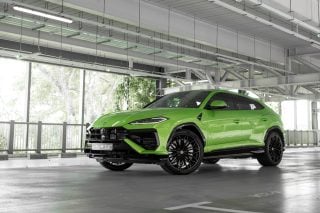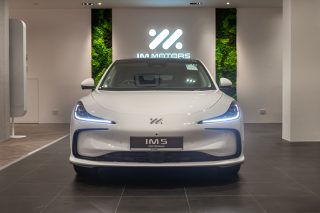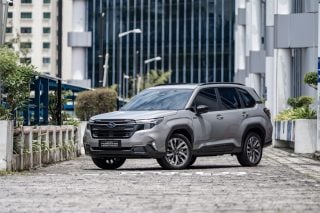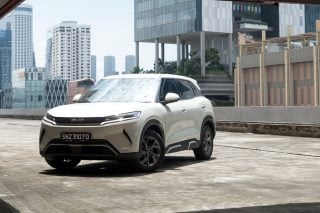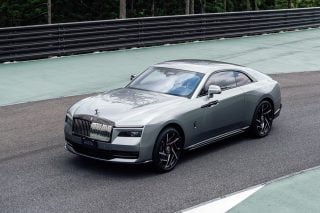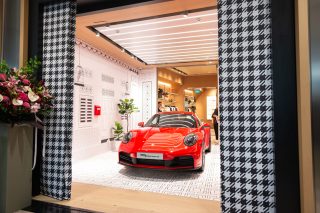
The Nissan Juke Turbo is a quirky mixture of sports car and sports utility vehicle.
Legions of Latio and Cefiro owners will probably disagree, but Nissan has a real sense of humour. And the Sunny is not the funny part. Instead, it is the compact hatchback you see here – the Juke Turbo.
This quirky name, by the way, has nothing to do with “jukebox”. Nissan marketers hijacked the American football term used to describe a quarterback’s sudden jerk to one side to avoid a defensive player’s tackle. Thankfully, they decided to call the car “Juke” rather than “Jerky”.

Nissan Juke Turbo’s funky, motorbike-inspired cockpit offers great visbility thanks to the elevated ride height and big mirrors; “blister” headlamp covers help you “see” the front corners of the car.
The only beef here is under the bonnet, where a powerful 1.6-litre engine resides. It has high-pressure direct injection, a high-boost turbocharger and a ticket to a higher-than-expected tax bracket, because its capacity is 1618cc, which puts it in COE Category B.
The engineering integrity of the Nissan Juke Turbo extends to its Qashqai-derived multi-link rear suspension, which replaces the simpler and cheaper torsion beam setup of the naturally aspirated Juke model. The tech fest also includes Nissan’s newest-generation CVT and a clever, class-first torque vectoring feature for the optional four-wheel drive system.

“Motorcycle” binnacle has its own little visor, a simulated aluminium finish and a distinctive demarcation of the tachometer’s redline zone.
Yes, the Juke is more than a pretentious city slicker whose idea of off-road is a patch of grass with a couple of grasshoppers. Anyway, the Juke driver is unlikely to stray from the concrete jungle. His car is too smooth for the rough stuff, and the 170mm of ground clearance (just a bit better than the Sylphy’s) is only enough for small kerbs, not big rocks. In other words, the Juke just needs to look like a domesticated Tarzan on wheels, with nice shoes.
The 17-inch footwear is indeed attractive and its “socks” (black plastic claddings) are cool. Even cooler is the rest of the exterior design. It is manga made metal, with a fascia inspired by rally cars but with a twist – what looks like fog lamps are actually the main headlights, while the sharp glass turrets above house the auxiliary lights and turn indicators.

Aftermarket touchscreen hi-fi comes with iPod plug-and-play, but the system is less impressive than the brilliant dual-illumination interface of the climate/D-mode control panel, whose two knobs, however, are strangely flimsy.
Other funky design touches are the boomerang-shaped tail-lamps (modelled on those of the 370Z sportster) and the rear door handles “hidden” in the C-pillars. The Juke is surely the most dramatic-looking Nissan this side of a GT-R, and similarly larger than life.
It is actually a small vehicle, with a shorter wheelbase than the Mitsubishi i mini-car. The road space occupied by the Nissan Juke Turbo is barely bigger than that of a Latio hatchback, and the roof line is lower than the Qashqai’s. There is much less interior space than the larger crossover, of course, but efficient packaging of the cabin and underpinnings has resulted in reasonable roominess.

However, access to the rear seat is quite tight due to the awkward and limited door apertures, the seating position is upright and the ceiling teases your follicles, but legroom is surprisingly decent.
Another surprise is the boot, whose 207-litre capacity is presented in an even shape and supplemented by a useful under-floor box for whatever. It can be easily removed for use as a basket. Not so easy to detach is the tonneau cover, which is integrated neatly with the inside of the tailgate but is a bit of a fiddle.

Nissan Juke Turbo’s Intelligent Control Display is an intriguing blend of Nissan GT-R and PlayStation, but its tactile quality is closer to the Sony than the supercar.
In the cockpit proper, the centrepiece is the centre console. Painted the same colour as the bodywork, it is meant to resemble the fuel tank a motorbiker straddles. The instrument cluster, with its visor and cylindrical gauges, continues the motorbike design theme. Maybe Nissan should have gone all the way and turned the stalks into mock handlebars. Doing this would be no crazier than the door trim, supposedly inspired by scuba diving flippers!
For those who prefer to drive rather than dive, the Juke has a party trick called Intelligent Control Display. This multi-function, real-time digital driving device lets the jock in the Juke enjoy a dash of Tokyo techno-wizardry. There are three modes to play with – Eco, Normal and Sport.

Rear headroom is not as good as in the front, but there is adequate space for your legs after you negotiate the door openings; honeycomb-patterned fabric upholstery looks and feels fantastic.
“Eco” tries to improve your mileage by reducing air-con performance and cutting throttle response. It also calls up a variety of fuel economy charts to make you feel guilty about your gas-guzzling ways and compel you to drive more gently. “Normal” is for normal driving (duh), with the relevant systems in their regular settings.
“Sport” is, as its name suggests, the go-faster mode when you’re running late or feeling racy.

It displays a cartoon-like turbo boost gauge in place of the Normal tachometer, which is fascinating, but you need to keep your eyes on the road, because the drivetrain also turns hyperactive. The throttle pedal is more sensitive to your right-foot input, the revs in every “gear” are kept higher, and the engine even sounds busier. The electric assistance for the power steering is also reduced, making it noticeably heavier.
Steering feel doesn’t improve, though. It is still vague and artificial, like some game console joystick, but quick enough to throw the car around with reckless abandon.

Adding to the gaiety is an accelerometer, which is a bonus feature in the Intelligent Control Display. It measures the g-force as you accelerate, brake and change direction. But this is more a conversation piece for the passengers, because the driver cannot accelerate, brake and change direction safely while looking at the g-meter.
If only it had a recording function, and perhaps a stopwatch, too.

Nissan Juke Turbo’s 1618cc turbo-boosted engine has a specific power output higher than the Volkswagen Golf GTI’s, but its cubic capacity is a minor disaster in the COE context.
The time the Nissan Juke Turbo takes to go from standstill to 100km/h is under 8 seconds. This is massive 3.5-litre Murano performance packed into a mini-SUV. The mighty little engine needs at least 3000rpm on the dial before the turbo really starts whooshing and working hard, motoring ahead with gusto as the CVT keeps the car in its noisy power zone.
There is a penalty to be paid at the pumps, though, with the test car’s fuel economy only half as good as the official figure if you push the Nissan Juke Turbo hard.
It bounces a little through bumpier corners and the ride is quite unsettled over uneven tarmac, but the basic handling is stable and precise, with strong brakes operated by a firm and well-modulated pedal. There is a touch of torque steer when accelerating aggressively on some surfaces, but this is nothing serious.

Specifying four-wheel drive would help put the ample power down. The system is able to split and shuffle the torque front to rear and also side to side across the rear axle, improving the Juke’s agility and stability in all conditions.
In all, the Nissan Juke Turbo is a seriously good toy for the young and sporty. But it costs more than a premium-spec Qashqai, which is less dynamic but a more complete partner for the daily grind.
The Nissan newcomer is undoubtedly a unique crossover with character, but it might not be special enough to justify its price.
Nissan Juke Turbo 1.6 (A)
ENGINE 1618cc, 16-valves, inline-4, turbocharged
MAX POWER 190bhp at 5600rpm
MAX TORQUE 240Nm at 2000-5200rpm
GEARBOX CVT with 6-speed override
0-100KM/H 7.8 seconds
TOP SPEED 200km/h
CONSUMPTION 13km/L
PRICE INCL. COE $143,300 (as of January 2011)
Check out the Nissan X-Trail
Nissan JukeCam is the world’s first integrated multi-purpose 360º camera
Group Test: Honda Jazz RS 1.5 vs Hyundai Veloster 1.6 vs Nissan Juke 1.6







